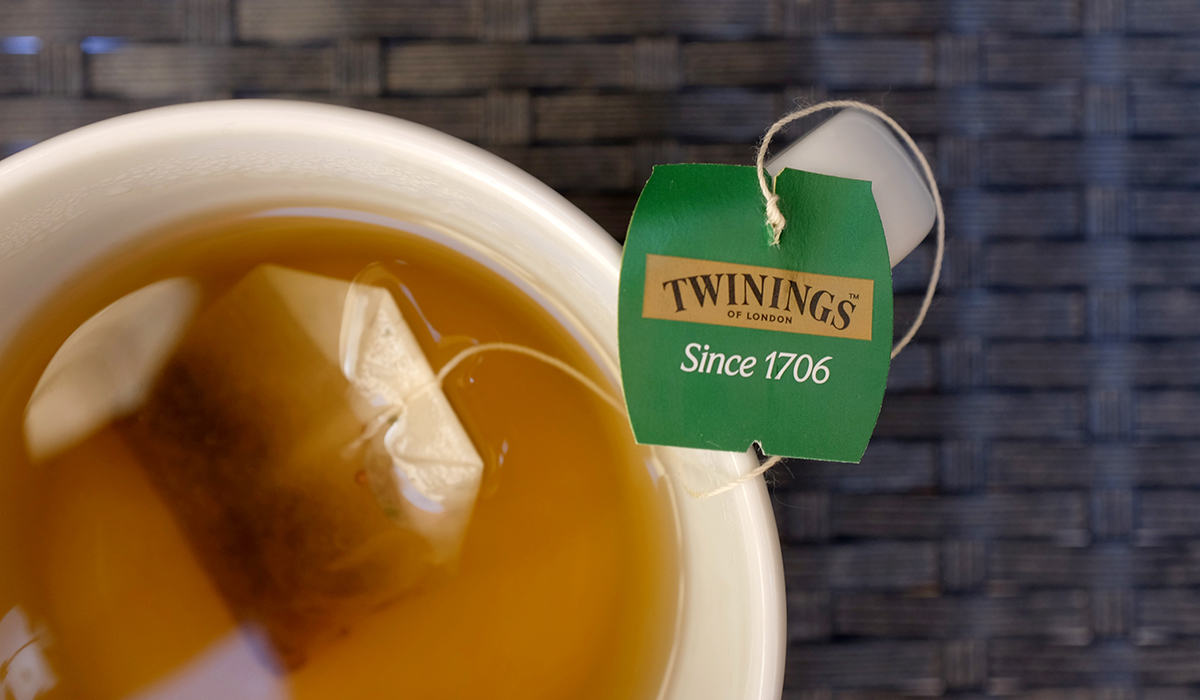We all know what Earl Grey is, right? Black tea and bergamot – simple. It’s a classic combination that’s been around for centuries.
But is it still Earl Grey if you use a different tea base? Or, is it just a bergamot flavoured tea without the prestige and heritage of the original?
Well, that’s up for some debate.
So when I saw a box of Twinings Green Tea Earl Grey at my local supermarket, I couldn’t resist throwing it into my basket to review.
What’s the worst that can happen?
I love both Earl Grey and green tea. So at the very least, I get to sample some tasty tea.
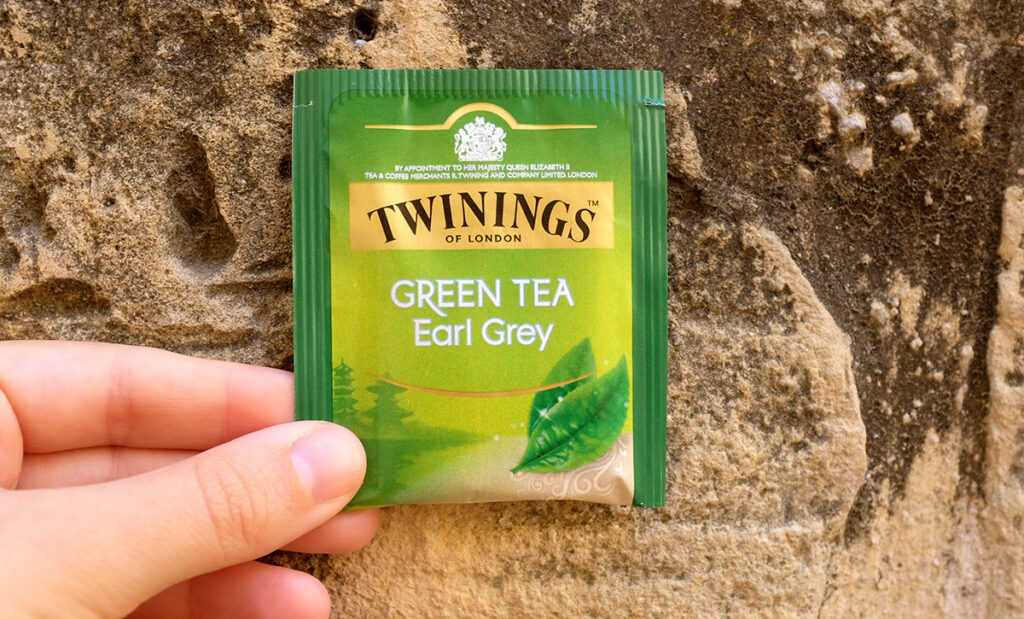
Table of Contents
- Blending Tea Since 1706
- No Strict Recipe
- Same Tree, Different Tea
- Green, Green, Green, and a Little Bit of Gold
- Earl Grey Aroma
- Strength and Taste
- Brew Time Test
- Re-Steeping Twinings Green Tea Earl Grey
- Inside the Tea Bag
- Are Twinings Earl Grey Green Tea Bags Plastic-Free?
- Final Thoughts…
Blending Tea Since 1706
Arguably, if anyone can mess with the Earl Grey recipe (and get away with it), Twinings can.
Not only have they been blending tea since 1706, but Twinings claim to be among the first to produce and sell Earl Grey tea as we know it today. Although, this is disputed.
They even have approval from the current Earl Grey. Each of their Earl Grey boxes proudly displays his signature.
And while the type of tea can vary, even Twinings’ own website states that Earl Grey is made with black tea – not green.
But just like the history of Earl Grey tea, the recipe isn’t straightforward.
No Strict Recipe
Unlike Lady Grey tea, Earl Grey doesn’t have a specific recipe to follow. In fact, there are several Earl Grey origin stories behind this famous tea.
But while there are countless types of Earl Grey to choose from, one thing remains constant – bergamot.
The black tea base, though? Well, that’s where it gets a little tricky.
One popular black tea choice, however, is Keemun (or Qimen in Chinese). It’s the same tea that Twinings use in their original Earl Grey blend.
Our Finest Keemun is gentle and light, with layers of flavour – both smoky and malty with a hint of nuttiness.
Twinings of London
Sweet, nutty, malty, and a little bit fruity, Keemun is a light, easy-drinking black tea. So light and mellow, in fact, that this black tea doesn’t require milk.
It’s said that Keemun tea was inspired by the Fujian Lapsang Souchong black tea. A smokey blend that is often used as a seasoning – not just tea.
And while Keemun is a black tea, it’s a lot more mellow and subtle than a Lapsang Souchong or Assam. Apparently, it’s also lower in caffeine.
Same Tree, Different Tea
But how does it compare to green tea? Well, they’re more similar than you’d think.
Like all caffeinated teas, black and green tea come from the Camellia Sinesis plant.
In fact, Keemun is harvested from the same Chinese variety that’s typically used for green tea production.
And, like Keemun, green tea doesn’t require milk.
The main difference between the two tea’s is how the leaves are picked and processed. That and the taste, of course.
So how does that affect the Earl Grey flavour? Well, let’s get on with the review and find out.
Green, Green, Green, and a Little Bit of Gold
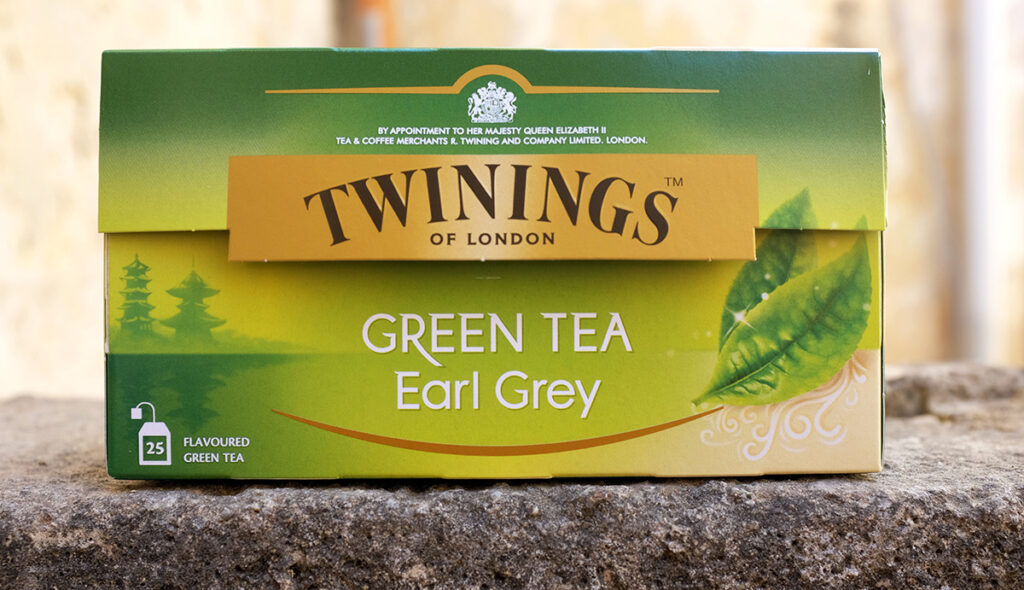
Similar in style to the Twinings Earl Grey (International Blend) box, the packaging is well constructed and sturdy.
There are no perforated edges or vertical openings like some of the other Earl Grey brands. But, the design is clean and the box has a very functional lid that feels secure.
Let’s put it this way. If you were to accidentally drop the box, there’s no risk of the teabags falling out.
The colour scheme matches the tea – green! I don’t love the imagery, but overall it’s quite modern with a hint at its Chinese roots.
The gold cutout Twinings logo kind of saves it and gives it a premium style aesthetic.
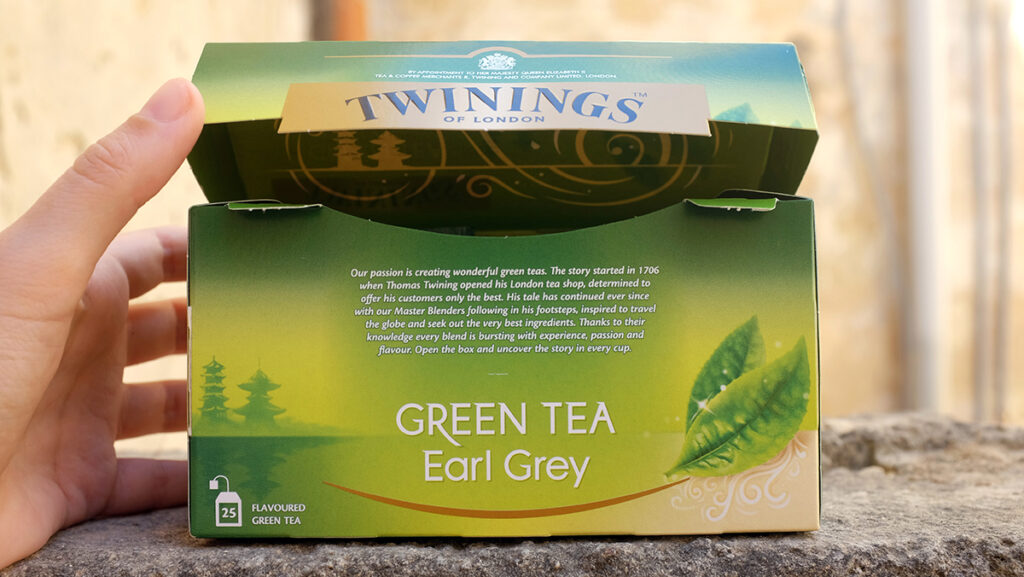
Inside the box, there are 25 teabags which equates to 40 grams in total.
Each Twinings Green Tea Earl Grey tea bag is individually packed and weighs around 1.6 grams.
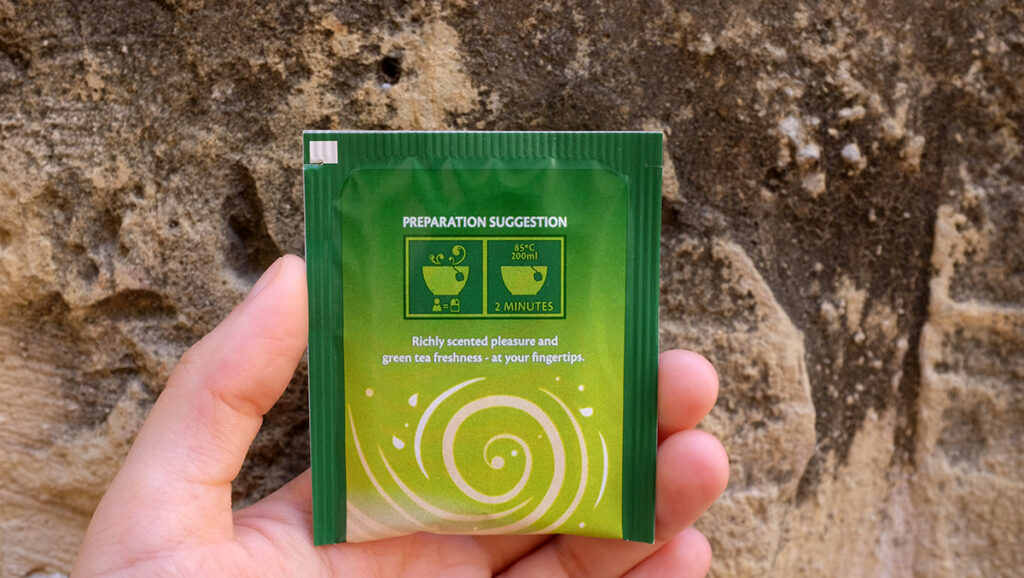
| Temperature | Water Quantity | Steep Time |
| 85 celsius | 200 millilitres | 2 minutes |
Earl Grey Aroma
I’m not sure if it’s just me, but I can’t smell much at all.
The aroma is extremely subtle. It’s mostly reminiscent of green tea – grassy hay with a tiny bit of citrus. And that’s with giving it a good sniff.
The bergamot is virtually undetectable, if at all. I’m starting to think it was all a subliminal suggestion brought on by the packaging. Or, perhaps it was just wishful thinking.
Honestly, I’m quite disappointed. Let’s hope the taste fairs better than the scent.
Strength and Taste
Like a delicate Jasmine tea, there’s a slight perfumed floral taste. This is followed by the peppery undertone you get with an Earl Grey.
Again, like the aroma, the bergamot is subtle. I mostly taste green tea. I even tried it again, this time with a longer steep time, to see if the flavour intensified. It didn’t.
If anything, keeping it in longer created a bit of a bitter sour aftertaste. Something that’s common when you over-steep a green tea.
Don’t leave your tea bag in your cup for too long because this gives it the bitter taste.
Twinings of London
It’s a nice and light green tea. Perfectly acceptable as a standalone green tea. But the Earl Grey? Well, that part is kind of gets lost along the way.
Brew Time Test
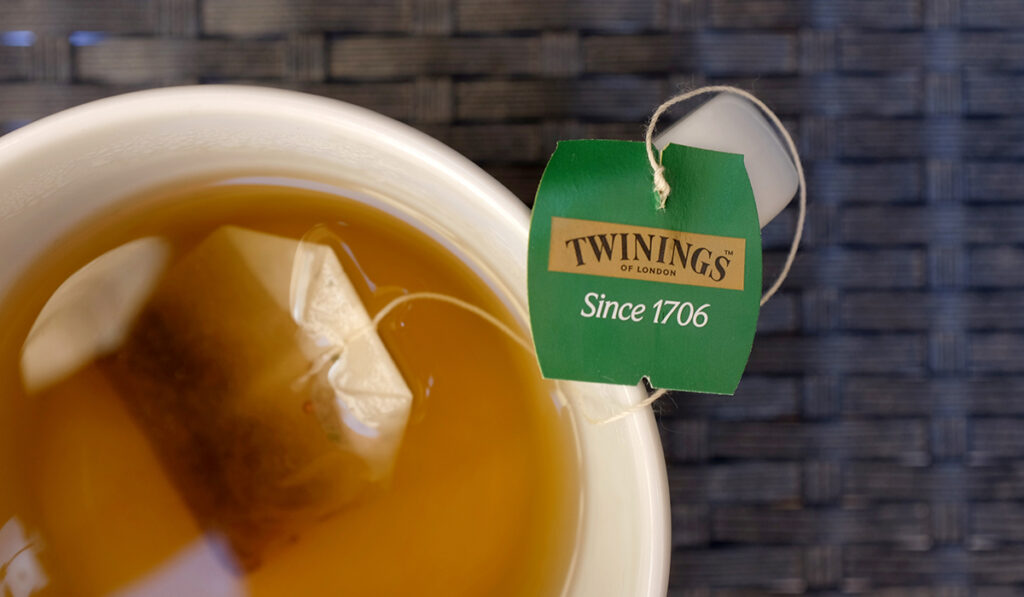
Equipment: Kettle, Mug, Measuring Jug, Thermometer, Stopwatch, Bottled Water, and a Twinings Earl Grey Green Tea Foiled Tea Bag.
Method: Using a stopwatch, I tested the Earl Grey tea at different time intervals. I noted down any taste, flavour, and colour differences along the way.
And here are the results.
1 min…
After about 30 seconds, the colour makes an appearance. It’s still a weak, pale yellow, but it’s there.
There’s not much tea taste yet, but there’s a faint floral and citrus taste.
2 mins…
The colour and perfumed, floral taste starts to intensify. But it’s still very subtle compared to your traditional Earl Grey tea.
Given that this is Twinings recommended steep time, I’d expect more flavour at this point.
3 mins…
The grassy, green tea flavour is starting to shine through. There’s a little more citrus, but it’s not nearly enough for my palate.
4 mins…
There’s not much change. Although there is a slightly soapy, tangy, and almost bitter aftertaste that’s not very pleasant.
5 mins…
No notable change.
10 mins…
The bergamot starts to pop, but the tea is now a little bitter. It’s tasty and the weird soapy aftertaste has gone. However, the balance between the tea and bergamot flavour is off.
Oh hell, let’s leave it in…
It begins to become bitter after approximately an hour. At this stage, green tea is the overriding taste and the bergamot starts to fade into the background.
After a while, it starts to become unpleasant.
Overall I’d say 3 minutes is the sweet spot. It’s the only time where the tea and bergamot don’t fight with each other.
Also worth noting is the amount of sediment at the bottom of the cup.
Re-Steeping Twinings Green Tea Earl Grey
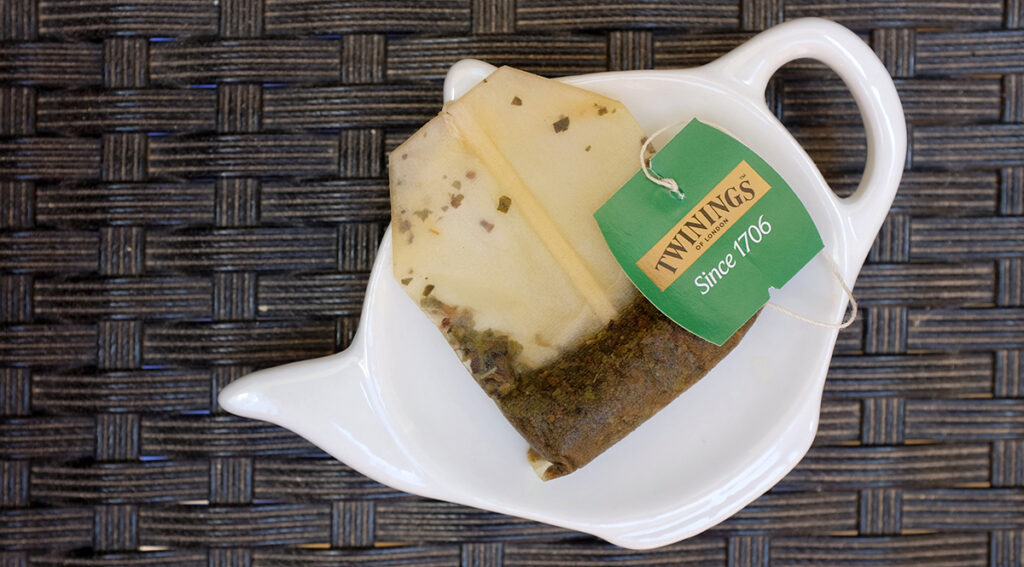
If you steep the tea bag for the recommended 2 minutes, re-steeping is possible. However, it is going to be a little weaker.
Unlike Twinings Earl Grey International Blend, you could probably get away with a third steep. But this depends on how strong you like your green tea.
The colour you get from the re-steeped tea bag is lighter. There’s less sediment than the initial steep too.
If you’re expecting a bold and brash Earl Grey flavour though, you’re going to be disappointed.
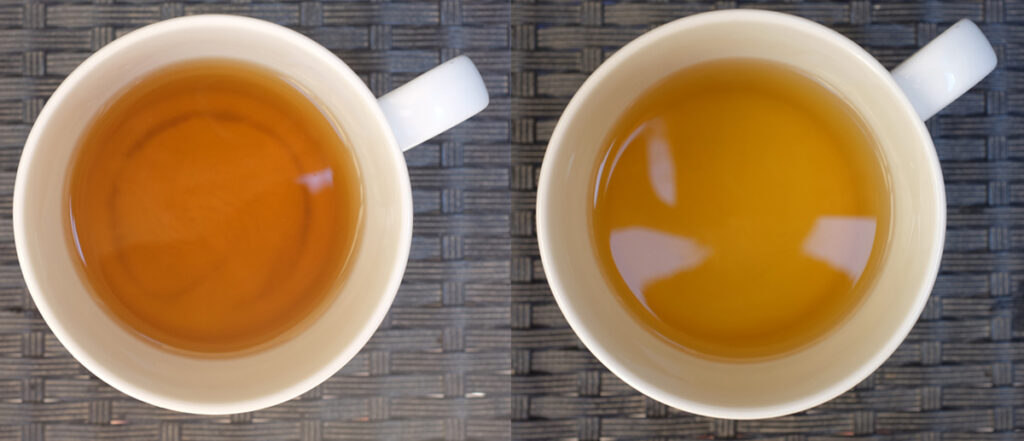
Inside the Tea Bag
Ingredients
- Green Tea (95.5%)
- Bergamot Flavouring (4.5%)
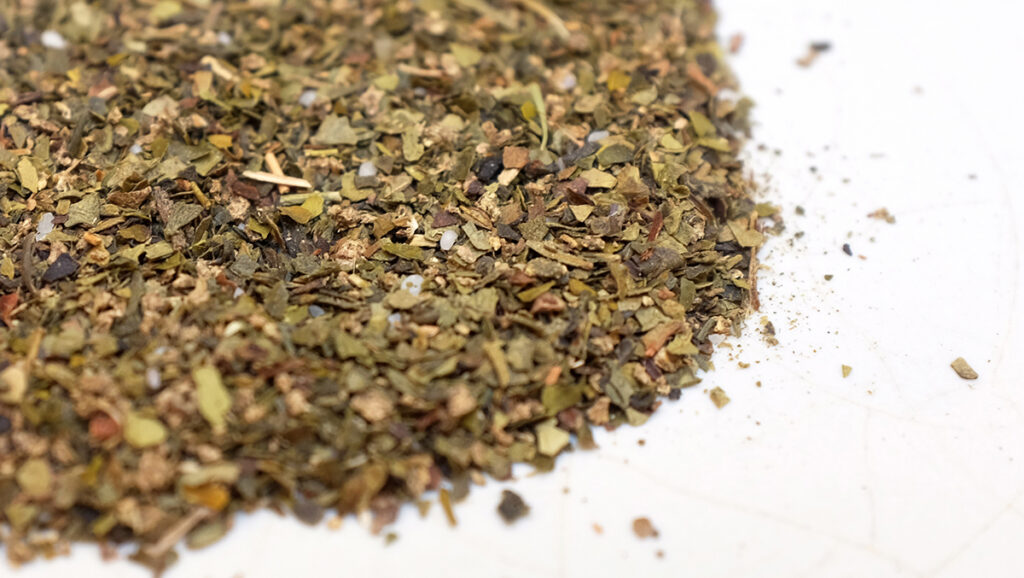
Green Tea
There are several ways in which green tea is produced. Unfortunately, like their Earl Grey with black tea, Twinings doesn’t go into much detail about their ingredients.
However, I did manage to find out that their green tea is sourced from India and China.
Unlike Keemun, green tea is harvested up to 3-4 times a year.
Once harvested, the leaves are heat-treated rather than oxidised like black tea. This helps the leaves keep their green colour and prevents them from going brown.
There are several different methods of heat-treating green tea. This includes anything from sun-drying and charcoal-firing to steaming and oven-drying.
When examining the tea bag contents, the leaves are a mix of colours. They range from green, beige, brown, and even a little yellow.
Like most bagged tea, the leaves are broken. But they’re not as finely ground as some other brands.
Bergamot Flavouring
According to the ingredients list, there’s 4.5% bergamot flavouring in this Earl Grey.
That’s 1.5% more than Twinings Earl Grey International Blend and 0.5% more than The Earl Grey from the UK.
However, when I compare the taste of the International Blend versus the Twinings Green Tea Earl Grey, I feel the bergamot flavour is lacking.
The flavouring comes in the form of small, white, crystal spheres which are dispersed throughout.
When I single out one of these flavouring crystals to taste, the flavour is similar to the ones found in the Twinings Earl Grey International Blend. But, they’re not quite as sweet or citrusy as I remember.
Instead, the flavour leans more heavily towards the peppery and floral notes of the bergamot.
Nutrition Information
| Typical Values | Per 100ml Brewed Black Tea (without milk)* |
| Energy | 2.3kJ / 0.6 kcal |
| Fat | 0g |
| of which saturates | 0g |
| Carbohydrate | 0.1g |
| of which sugars | 0g |
| Protein | 0.4g |
| Salt | 0g |
Are Twinings Earl Grey Green Tea Bags Plastic-Free?
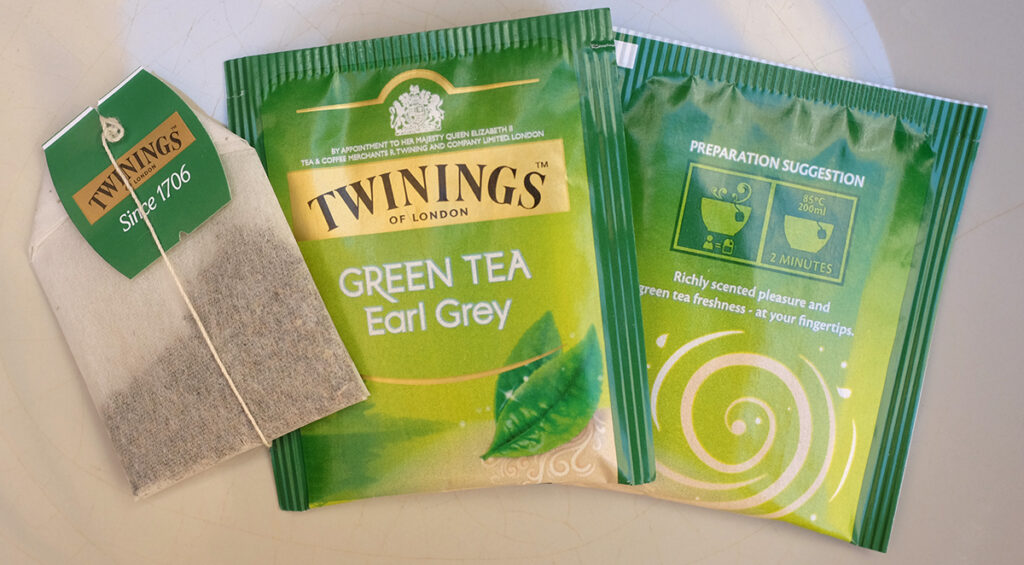
from January 2020 we are changing all our traditional teabags into a new type of paper that is entirely plant-based and fully biodegradable.
Twinings of London
Twinings are trying to find a material that is fully biodegradable. However, some of their teabags are still heat-sealed.
Heat-sealed teabags often contain a thin film of polypropylene to keep the bag closed.
The only Twinings teabags that are 100% plastic-free are their pyramid range. Although the label on these teabags will need to be removed before composting. This is because the label has a thin layer of plastic to prevent it from getting wet if it falls into your brew.
We are also working to transfer all our ‘tag’ teabags into this same material.
Twinings of London
When it comes to their string and tag teabags, Twinings use either a plant fibre or cellulose-based paper. “Some” of these these bags are then stitched with cotton. But not all.
To find out if your Twinings teabags are plastic-free, you should check the packet. Tea companies usually like to brag about that kind of thing.
Final Thoughts…
Overall Twinings Green Tea Earl Grey makes a pretty tasty brew.
I like the subtle orange bergamot taste that is there. And if I were at someones house and they offered it to me I’d happily oblige. But for me, it lacks the Earl Grey taste you’d expect from a teamaker like Twinings.
Does that mean green tea can’t be used? No, I don’t think so. Ultimately, I think it comes down to Twinings and their blend. More bergamot please!


